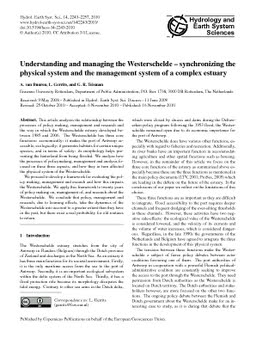2010-11-30
Understanding and managing the Westerschelde. Synchronizing the physical system and the management system of a complex estuary.
Publication
Publication
Hydrology and Earth System Sciences , Volume 14 - Issue 11 p. 2243- 2257
Abstract. This article analyzes the relationship between the processes of policy making, management and research and the way in which the Westerschelde estuary developed be- tween 1985 and 2006. The Westerschelde has three core functions: economically: it makes the port of Antwerp ac- cessible; ecologically: it generates habitats for certain unique species; and in terms of safety: its morphology helps pre- venting the hinterland from being flooded. We analyze how the processes of policymaking, management and analysis fo- cused on these three aspects, and how they in turn affected the physical system of the Westerschelde. We proceed to develop a framework for evaluating the pol- icy making, management and esearch and how this impacts the Westerschelde. We apply this framework to twenty years of policy making on, management of, and research about the Westerschelde. We conclude that policy, management and research, due to learning effects, take the dynamics of the Westerschelde into account to a greater extent than they have in the past, but there exist a real probability for old routines to return.
| Additional Metadata | |
|---|---|
| doi.org/10.5194/hess-14-2243-2010, hdl.handle.net/1765/21452 | |
| Hydrology and Earth System Sciences | |
| Organisation | Department of Public Administration |
|
van Buuren, A., Gerrits, L., & Teisman, G. (2010). Understanding and managing the Westerschelde. Synchronizing the physical system and the management system of a complex estuary. Hydrology and Earth System Sciences, 14(11), 2243–2257. doi:10.5194/hess-14-2243-2010 |
|

